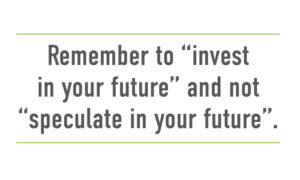Imagine going to the supermarket with a simple goal: purchase food for the week. Easy enough, but of course there are the food allergies, the 6-year-old-child-turned-Michelin-star foodie, and the M&M impulse buying at checkout. A bit dramatic, but the point is distractions impact the success of even the simplest goals. The stock market is a place where those looking to purchase financial assets meet those looking to sell financial assets, but there is a lot of noise that can derail a long term plan. High fees, speculative behavior, and lack of diversification are things you do not want clouding your investments because it will reduce returns and impact your financial goals.
How do you know what to invest in? Individual Stocks, Mutual Funds, or ETFs? What the heck is an ETF? Let’s cut through some more jargon and bring some simplicity to investing.

Mutual Fund: A vehicle made up of a pool of investors who contribute cash to purchase shares of a company. That company is a mutual fund and is operated by managers who allocate the investor’s money into various securities and is structured to match the investment objectives stated in its prospectus. Mutual funds often have names that include a sector or geographic region. These names give an idea of how the mutual fund managers are investing. The price of a mutual fund is based on its Net Asset Value (“NAV”) which is determined daily at the end of trading – and trading only occurs once per day after the markets have closed. Mutual funds charge fees that reduce returns and will vary.
Exchange Traded Fund (ETF): A vehicle that tracks an index, sector, commodity, investment strategy or other asset. An investor in an ETF will pay cash in exchange for shares of a company. That company is an ETF and trades just like individual securities, so their price will fluctuate throughout the trading day. It is common for ETFs to have names that reflect the type of index, sector, or investment strategy they are tracking. ETF charge fees that reduce returns and will vary.
Active Management: An investment style that requires a professional manager to actively track the market and will regularly buy, hold, and sell individual securities to take advantage of market timing opportunities. The goal is to outperform the overall market. Since an active management strategy requires the work of professional managers, fees tend to be higher.
Passive Management: An investment style that adheres to simply tracking the performance of the overall market without actively buying and selling individual securities in the hopes to outperform the market. Passive management is the opposite of active management. Other common terms you might hear are “passive investing”, “index investing”, or “passive strategy”. Since passive management does not require a team of professionals to research, track, and execute trades, fees tend to be lower.
Diversification: A strategy that mixes a range of investments in a given portfolio. A diversified portfolio attempts to limit exposure to any single asset, and on average should deliver higher long-term returns and lowers the risk of holding any individual security. Diversification can be incorporated by asset class (stocks vs. bonds), and within an asset (mutual funds/ETFs). I have had clients tell me that diversification only reduces potential returns, but remember risk is a double edged sword, as much as you could make, you could also lose.
Fees: Fees in the financial industry are about as clear as mud, and it is a tremendous disservice to investors that put hard earned dollars in financial products that are expensive or even inappropriate for them. There will be more to come in fees, but some basic tips for starters:
Management Fees/Expense Ratios: Check the annual expenses on any mutual fund or ETF before investing. A passively managed fund should be close to 0% in fees – you are just tracking an index. Actively managed funds will be more expensive, and history has shown they don’t outperform a passively managed fund after considering fees in the long term.
Fund Turnover: I have seen clients crushed by capital gains in active funds that constantly buy and sell securities. Funds don’t report returns after taxes, but take it from this tax nerd that tax drag has a huge impact on investment returns.
Advisors: If you are working with an advisor – ask them how they are compensated and if they are a fiduciary. There are many financial professionals who receive their compensation in the form of commissions, kickbacks, or referrals from expensive and low performing mutual funds or expensive and unnecessary insurance products. A fiduciary is legally bound to act in their clients best interest and should be the standard you hold the person giving you personal financial advice to. I strongly recommend working with a credentialed planner, operating as a “fee only” fiduciary.

Getting Started Portfolio:
For starters, I recommend a diversified portfolio of low cost, passively managed mutual funds or ETFs that you make ongoing contributions to. There is a community of devoted index investors known as “Bogleheads”, named after the famous Jack Bogle who spent his life championing the passive investment strategy. Many Bogleheads subscribe to the 3 fund portfolio – where you simply divide your investment contributions between a total US stock market fund, a total international stock market fund, and a total bond market fund. Investing this way provides both diversification and low fees. You are invested in everything at a low cost. The 3 fund portfolio is a great way to get started!
Lay your foundation with a low cost diversified portfolio. If you have the itch to be more active in your investment activities (and there is nothing wrong with that!), I recommend a separate brokerage account with a budgeted amount you contribute and keep it separate from your foundational wealth building accounts. Remember to “invest in your future” and not “speculate in your future”.
